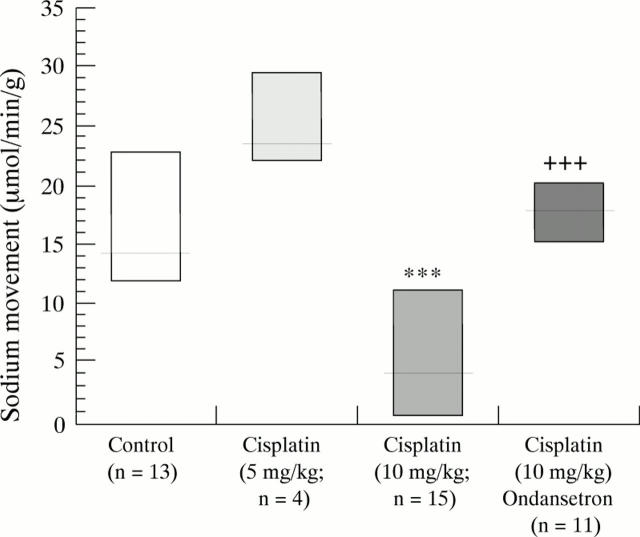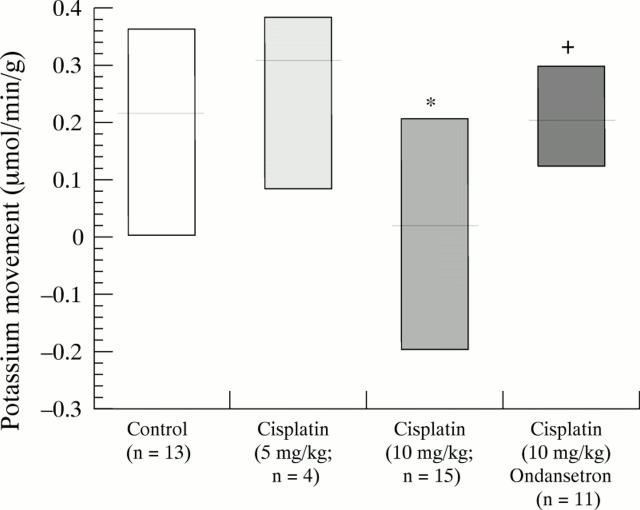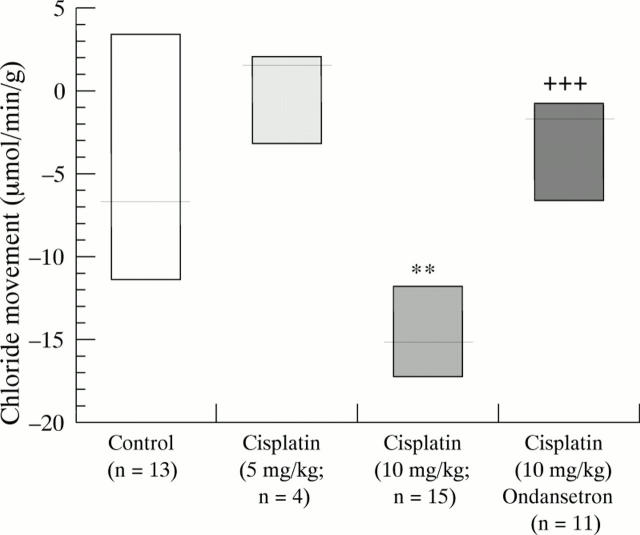Abstract
Background—The antineoplastic drug cisplatin has been widely used for the treatment of cancer in humans but its use has been limited by vomiting and diarrhoea. Cisplatin releases 5-hydroxytryptamine into the gut which is thought to be the major mediator of cisplatin induced vomiting. Aim—To determine whether cisplatin affects fluid and electrolyte transport in rat jejunum and whether this change can be modulated by the 5-hydroxytryptamine3 receptor antagonist, ondansetron. Methods—Jejunal perfusion in rats in vivo was performed one hour after intraperitoneal cisplatin (5 and 10 mg/kg) administration. The effect of pretreatment with subcutaneous ondansetron 300 µg/kg was investigated. Results—Median net fluid absorption after cisplatin 10 mg/kg (67 µl/min/g dry intestinal weight (interquartile range 46 to 100); n = 15) was reduced compared with controls (120 (107to 151) µl/min/g; n = 13; p<0.001). Ondansetron reversed the impairment of jejunal fluid absorption produced by cisplatin to normal (161(130 to 176) µl/min/g; n = 11; p<0.001). Electrolyte movement paralleled fluid movement. Jejunal histological examination of sections from cisplatin treated animals showed villus damage, which was not prevented by pretreatment with ondansetron. Conclusion—These findings suggest that diarrhoea during cisplatin therapy may be due to altered fluid transport in the small bowel. The reversal of fluid transport to normal in the presence of a 5-hydroxytryptamine3 receptor antagonist suggests that 5-hydroxytryptamine is a local mediator in the small intestine.
Keywords: cisplatin; 5-hydroxytryptamine; rat; ondansetron; small intestine; fluid transport
Full Text
The Full Text of this article is available as a PDF (183.7 KB).
Figure 1 .
Net fluid movement (µl/min/g) in controls and animals treated with cisplatin or cisplatin and ondansetron. Values are expressed as median (horizontal line) and interquartile range (bar). ***p<0.001 compared with controls; †††p<0.001 compared with cisplatin 10mg/kg alone but no different from controls.
Figure 2 .
Net sodium movement (µmol/min/g) in controls and animals treated with cisplatin or cisplatin and ondansetron. Values are expressed as median (horizontal line) and interquartile range (bar). ***p<0.001 compared with controls; †††p<0.001 compared with cisplatin 10 mg/kg alone but no different from controls.
Figure 3 .
Net potassium movement (µmol/min/g) in controls and animals treated with cisplatin or cisplatin and ondansetron. Values are expressed as median (horizontal line) and interquartile range (bar). *p<0.05 compared with controls; †p<0.05 compared with cisplatin 10 mg/kg alone but no different from controls.
Figure 4 .
Net chloride movement (µmol/min/g) in controls and animals treated with cisplatin or cisplatin and ondansetron. Values are expressed as median (horizontal line) and interquartile range (bar). **p<0.01 compared with controls; †††p<0.001 compared with cisplatin 10 mg/kg alone but no different from controls.
Figure 5 .

Histological sections from (A) controls, (B) cisplatin (10 mg/kg) treated animals and (C) animals treated with cisplatin 10 mg/kg and ondansetron 300 µg/kg showing degeneration of the tips of the villi and enterocyte damage (arrows). These sections were selected to be representative of the histological appearance for each of the groups. An example of more serious damage after treatment with cisplatin 10 mg/kg is shown in (D), with denudation of the distal third of some of the villi which occurred in 23% of villi in one out of nine animals and was not present in all sections. All sections were examined in a blinded fashion but were `selected' to be representative of the histology in each of the treatment groups. Bar = 100 µm.
Selected References
These references are in PubMed. This may not be the complete list of references from this article.
- Allan S. G., Smyth J. F. Small intestinal mucosal toxicity of cis-platinum--comparison of toxicity with platinum analogues and dexamethasone. Br J Cancer. 1986 Mar;53(3):355–360. doi: 10.1038/bjc.1986.59. [DOI] [PMC free article] [PubMed] [Google Scholar]
- Anderson J. V., Coupe M. O., Morris J. A., Hodgson H. J., Bloom S. R. Remission of symptoms in carcinoid syndrome with a new 5-hydroxytryptamine M receptor antagonist. Br Med J (Clin Res Ed) 1987 May 2;294(6580):1129–1129. doi: 10.1136/bmj.294.6580.1129. [DOI] [PMC free article] [PubMed] [Google Scholar]
- Andrews P. L., Rapeport W. G., Sanger G. J. Neuropharmacology of emesis induced by anti-cancer therapy. Trends Pharmacol Sci. 1988 Sep;9(9):334–341. doi: 10.1016/0165-6147(88)90106-x. [DOI] [PubMed] [Google Scholar]
- Barnes N. M., Ge J., Jones W. G., Naylor R. J., Rudd J. A. Cisplatin induced emesis: preliminary results indicative of changes in plasma levels of 5-hydroxytryptamine. Br J Cancer. 1990 Nov;62(5):862–864. doi: 10.1038/bjc.1990.395. [DOI] [PMC free article] [PubMed] [Google Scholar]
- Bearcroft C. P., Farthing M. J., Perrett D. Determination of 5-hydroxytryptamine, 5-hydroxyindoleacetic acid and tryptophan in plasma and urine by HPLC with fluorimetric detection. Biomed Chromatogr. 1995 Jan-Feb;9(1):23–27. doi: 10.1002/bmc.1130090105. [DOI] [PubMed] [Google Scholar]
- Bearcroft C. P., Perrett D., Farthing M. J. 5-hydroxytryptamine release into human jejunum by cholera toxin. Gut. 1996 Oct;39(4):528–531. doi: 10.1136/gut.39.4.528. [DOI] [PMC free article] [PubMed] [Google Scholar]
- Beubler E., Bukhave K., Rask-Madsen J. Significance of calcium for the prostaglandin E2-mediated secretory response to 5-hydroxytryptamine in the small intestine of the rat in vivo. Gastroenterology. 1986 Jun;90(6):1972–1977. doi: 10.1016/0016-5085(86)90269-6. [DOI] [PubMed] [Google Scholar]
- Beubler E., Horina G. 5-HT2 and 5-HT3 receptor subtypes mediate cholera toxin-induced intestinal fluid secretion in the rat. Gastroenterology. 1990 Jul;99(1):83–89. doi: 10.1016/0016-5085(90)91233-v. [DOI] [PubMed] [Google Scholar]
- Beubler E., Kollar G., Saria A., Bukhave K., Rask-Madsen J. Involvement of 5-hydroxytryptamine, prostaglandin E2, and cyclic adenosine monophosphate in cholera toxin-induced fluid secretion in the small intestine of the rat in vivo. Gastroenterology. 1989 Feb;96(2 Pt 1):368–376. doi: 10.1016/0016-5085(89)91560-6. [DOI] [PubMed] [Google Scholar]
- Binks S. P., Dobrota M. Kinetics and mechanism of uptake of platinum-based pharmaceuticals by the rat small intestine. Biochem Pharmacol. 1990 Sep 15;40(6):1329–1336. doi: 10.1016/0006-2952(90)90400-f. [DOI] [PubMed] [Google Scholar]
- Blower P. R. The role of specific 5-HT3 receptor antagonism in the control of cytostatic drug-induced emesis. Eur J Cancer. 1990;26 (Suppl 1):S8–11. [PubMed] [Google Scholar]
- Butler A., Hill J. M., Ireland S. J., Jordan C. C., Tyers M. B. Pharmacological properties of GR38032F, a novel antagonist at 5-HT3 receptors. Br J Pharmacol. 1988 Jun;94(2):397–412. doi: 10.1111/j.1476-5381.1988.tb11542.x. [DOI] [PMC free article] [PubMed] [Google Scholar]
- Cassuto J., Jodal M., Tuttle R., Lundgren O. 5-hydroxytryptamine and cholera secretion. Physiological and pharmacological studies in cats and rats. Scand J Gastroenterol. 1982 Aug;17(5):695–703. doi: 10.3109/00365528209181081. [DOI] [PubMed] [Google Scholar]
- Cubeddu L. X., Hoffmann I. S., Fuenmayor N. T., Finn A. L. Efficacy of ondansetron (GR 38032F) and the role of serotonin in cisplatin-induced nausea and vomiting. N Engl J Med. 1990 Mar 22;322(12):810–816. doi: 10.1056/NEJM199003223221204. [DOI] [PubMed] [Google Scholar]
- Cubeddu L. X., Hoffmann I. S., Fuenmayor N. T., Malave J. J. Changes in serotonin metabolism in cancer patients: its relationship to nausea and vomiting induced by chemotherapeutic drugs. Br J Cancer. 1992 Jul;66(1):198–203. doi: 10.1038/bjc.1992.242. [DOI] [PMC free article] [PubMed] [Google Scholar]
- Cunningham D., Morgan R. J., Mills P. R., Nelson L. M., Toner P. G., Soukop M., McArdle C. S., Russell R. I. Functional and structural changes of the human proximal small intestine after cytotoxic therapy. J Clin Pathol. 1985 Mar;38(3):265–270. doi: 10.1136/jcp.38.3.265. [DOI] [PMC free article] [PubMed] [Google Scholar]
- Davidson H. I., Andrews P. L. Stimulation of gastrointestinal motility by cisplatin in the ferret: activation of an intrinsic cholinergic mechanism dissociated from emesis. Naunyn Schmiedebergs Arch Pharmacol. 1993 May;347(5):506–513. doi: 10.1007/BF00166743. [DOI] [PubMed] [Google Scholar]
- Donowitz M., Binder H. J. Jejunal fluid and electrolyte secretion in carcinoid syndrome. Am J Dig Dis. 1975 Dec;20(12):1115–1122. doi: 10.1007/BF01070754. [DOI] [PubMed] [Google Scholar]
- Donowitz M., Charney A. N., Heffernan J. M. Effect of serotonin treatment on intestinal transport in the rabbit. Am J Physiol. 1977 Jan;232(1):E85–E94. doi: 10.1152/ajpendo.1977.232.1.E85. [DOI] [PubMed] [Google Scholar]
- Hardcastle J., Hardcastle P. T., Redfern J. S. Action of 5-hydroxytryptamine on intestinal ion transport in the rat. J Physiol. 1981 Nov;320:41–55. doi: 10.1113/jphysiol.1981.sp013933. [DOI] [PMC free article] [PubMed] [Google Scholar]
- Kris M. G., Gralla R. J., Clark R. A., Tyson L. B., Groshen S. Control of chemotherapy-induced diarrhea with the synthetic enkephalin BW942C: a randomized trial with placebo in patients receiving cisplatin. J Clin Oncol. 1988 Apr;6(4):663–668. doi: 10.1200/JCO.1988.6.4.663. [DOI] [PubMed] [Google Scholar]
- Miner W. D., Sanger G. J. Inhibition of cisplatin-induced vomiting by selective 5-hydroxytryptamine M-receptor antagonism. Br J Pharmacol. 1986 Jul;88(3):497–499. doi: 10.1111/j.1476-5381.1986.tb10228.x. [DOI] [PMC free article] [PubMed] [Google Scholar]
- Mourad F. H., O'Donnell L. J., Dias J. A., Ogutu E., Andre E. A., Turvill J. L., Farthing M. J. Role of 5-hydroxytryptamine type 3 receptors in rat intestinal fluid and electrolyte secretion induced by cholera and Escherichia coli enterotoxins. Gut. 1995 Sep;37(3):340–345. doi: 10.1136/gut.37.3.340. [DOI] [PMC free article] [PubMed] [Google Scholar]
- Ohuchida A., Furukawa A. Micronucleus test of mofezolac (N-22). J Toxicol Sci. 1990 Jun;15 (Suppl 2):253–260. doi: 10.2131/jts.15.supplementii_253. [DOI] [PubMed] [Google Scholar]
- Rolston D. D., Borodo M. M., Kelly M. J., Dawson A. M., Farthing M. J. Efficacy of oral rehydration solutions in a rat model of secretory diarrhea. J Pediatr Gastroenterol Nutr. 1987 Jul-Aug;6(4):624–630. doi: 10.1097/00005176-198707000-00023. [DOI] [PubMed] [Google Scholar]
- Schwörer H., Racké K., Kilbinger H. Cisplatin increases the release of 5-hydroxytryptamine (5-HT) from the isolated vascularly perfused small intestine of the guinea-pig: involvement of 5-HT3 receptors. Naunyn Schmiedebergs Arch Pharmacol. 1991 Aug;344(2):143–149. doi: 10.1007/BF00167211. [DOI] [PubMed] [Google Scholar]
- Scott R. H., Manikon M. I., Andrews P. L. Actions of cisplatin on the electrophysiological properties of cultured dorsal root ganglion neurones from neonatal rats. Naunyn Schmiedebergs Arch Pharmacol. 1994 Mar;349(3):287–294. doi: 10.1007/BF00169295. [DOI] [PubMed] [Google Scholar]
- Siriwardena A. K., Smith E. H., Borum E. H., Kellum J. M., Jr Identification of a 5-hydroxytryptamine (5-HT2) receptor on guinea pig small intestinal crypt cells. Am J Physiol. 1993 Aug;265(2 Pt 1):G339–G346. doi: 10.1152/ajpgi.1993.265.2.G339. [DOI] [PubMed] [Google Scholar]
- Sjöqvist A., Cassuto J., Jodal M., Lundgren O. Actions of serotonin antagonists on cholera-toxin-induced intestinal fluid secretion. Acta Physiol Scand. 1992 Jul;145(3):229–237. doi: 10.1111/j.1748-1716.1992.tb09360.x. [DOI] [PubMed] [Google Scholar]
- Torii Y., Mutoh M., Saito H., Matsuki N. Involvement of free radicals in cisplatin-induced emesis in Suncus murinus. Eur J Pharmacol. 1993 Aug 2;248(2):131–135. doi: 10.1016/0926-6917(93)90034-n. [DOI] [PubMed] [Google Scholar]
- Turvill J. L., Farthing M. J. Effect of granisetron on cholera toxin-induced enteric secretion. Lancet. 1997 May 3;349(9061):1293–1293. doi: 10.1016/S0140-6736(97)24018-3. [DOI] [PubMed] [Google Scholar]
- Vadiei K., Siddik Z. H., Khokhar A. R., al-Baker S., Sampedro F., Perez-Soler R. Pharmacokinetics of liposome-entrapped cis-bis-neodecanoato-trans-R,R-1,2-diaminocyclohexane platinum(II) and cisplatin given i.v. and i.p. in the rat. Cancer Chemother Pharmacol. 1992;30(5):365–369. doi: 10.1007/BF00689964. [DOI] [PubMed] [Google Scholar]






